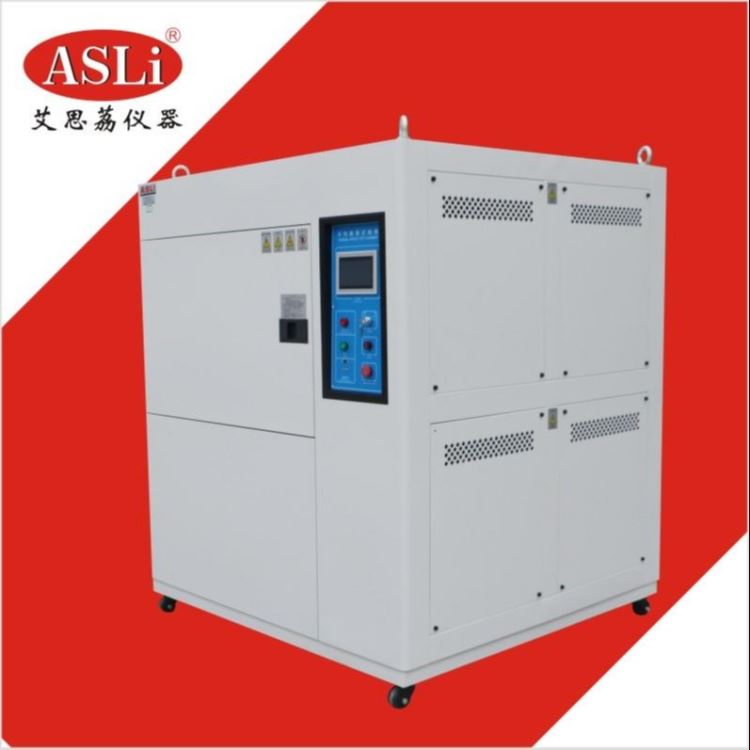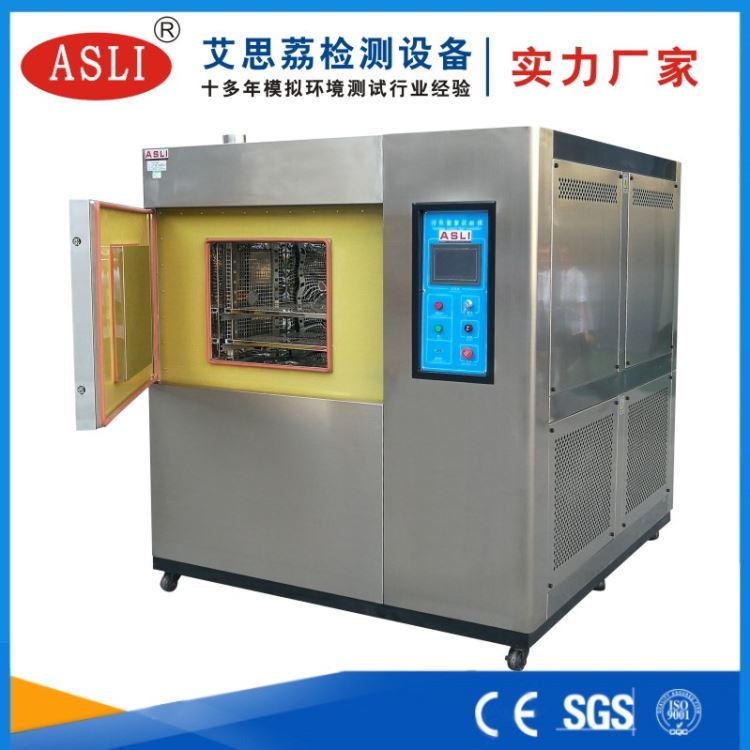| 品牌 : | 艾思荔 | 型号 : | TS-80 |
| 加工定制 : | 是 | 材质 : | 不锈钢 |
| 温度范围 : | -70-150度 | 测量范围 : | 见详细说明 |
| 工作室尺寸 : | 50×40×40 | 重量 : | 900KG |
'sans serif', tahoma, verdana, helvetica;font-size: 12px;white-space: normal">冷热冲击试验箱节能技术:
'sans serif', tahoma, verdana, helvetica;font-size: 12px;white-space: normal">优质冷热冲击试验机批发 黑龙江冷热冲击试验机厂家 山东冷热冲击试验机价格艾思荔TS-80
'sans serif', tahoma, verdana, helvetica;font-size: 12px;white-space: normal;text-indent: 28px">冷热冲击试验箱制冷压缩机启停控制温度(温度波动大、严重影响压缩机寿命,已淘汰的技术)制冷压缩机恒定运行+加热PID控制(导致制冷量与加热相抵消实现温度动态平衡,浪费了大量的电能)新型PWM冷控制技术实现低温节能运行:低温工作状态,加热器不参与工作,通过ASLI技术控制调节制冷机组制冷剂流量和流向,对制冷管道、冷旁通管道、热旁通管道三向流量调节,实现对工作室温度的自动恒定。此方式在低温工况下,可实现降低40%的能耗。 冷热冲击试验箱规格/SPEC/要可按客户要求订制
冷热冲击试验箱规格/SPEC/要可按客户要求订制
型 号 | TS-42(A~C) | TS-80(A~C) | TS-150(A~C) | TS-252(A~C) | TS-450(A~C) |
内部尺寸W×H×D(cm) | 40×35×30 | 50×40×40 | 60×50×50 | 70×60×60 | 80×75×75 |
外部尺寸W×H×D(cm) | 140×180×145 | 148×190×155 | 160×200×175 | 175×210×187 | 190×220×200 |
温度范围(测试区) | (150℃~A:-45℃;B:-55℃;C:-65℃);(高温区:+60℃~+150℃;低温区-10℃~-65℃) | ||||
升温时间(蓄热区) | RT~200℃约需35min | ||||
降温时间(蓄冷区) | RT~-70℃约需85min | ||||
温度回复时间/转换时间 | ≤5min内 / ≤l0秒内 | ||||
温度控制精度/分布精度 | ±0.5℃/±2.0℃ | ||||
保温材质 | 耐高温高密度氯基甲shuan乙醋泡沫绝缘体材料 | ||||
系统 | P.I.D + S.S.R + 微电脑平衡调温控制系统 | ||||
冷却系统 | 半密闭式双段压缩机(水冷式)/全密闭式双段压缩机(风冷式) | ||||
安全保护装置 | 无熔丝开关、压缩机高低压保护开关,冷媒高压保护开关、故障警告系统,电子警报器 | ||||
配 件 | 观视窗(特殊选购型)、上下可调隔层两片、通电测试孔、脚轮、水平支架 | ||||
电 源 | AC380V 50Hz/60Hz 3 ∮ | ||||
重量(大约 | 700Kg | 900Kg | l200Kg | 1400Kg | 1900Kg |
'sans serif', tahoma, verdana, helvetica;font-size: 12px;white-space: normal">
'sans serif', tahoma, verdana, helvetica;font-size: 12px;white-space: normal">冷热冲击试验箱特点:
'sans serif', tahoma, verdana, helvetica;font-size: 12px;white-space: normal">采用彩色中英文LCD触控式图控操作介面,操作简易.
'sans serif', tahoma, verdana, helvetica;font-size: 12px;white-space: normal">设备区分为高温区、低温区、测试区三部分,各区之箱体釆独特之断热结构。
'sans serif', tahoma, verdana, helvetica;font-size: 12px;white-space: normal">冲击方式应用风路切换方式将温度导入测试区,做冷热冲击测试。
'sans serif', tahoma, verdana, helvetica;font-size: 12px;white-space: normal">高温冲击或低温冲击时,*大时间可达9999分钟,*大循环周期可达9999次。
'sans serif', tahoma, verdana, helvetica;font-size: 12px;white-space: normal">系统可作自动循环冲击或手动选择性冲击并可设定二区或三区冲击及冷冲热冲启始。
'sans serif', tahoma, verdana, helvetica;font-size: 12px;white-space: normal">冷却采二元冷冻系统,降温效果快速,冷却方式为风冷式或水冷式两种。
'sans serif', tahoma, verdana, helvetica;font-size: 12px;white-space: normal">可连接电脑,记录仪仅为选购件。
'sans serif', tahoma, verdana, helvetica;font-size: 12px;white-space: normal">彩色LCD液晶触控式控制器的特点:
'sans serif', tahoma, verdana, helvetica;font-size: 12px;white-space: normal">控制器的各项操作皆以人机触控方式进行。
'sans serif', tahoma, verdana, helvetica;font-size: 12px;white-space: normal">人性化的图控介面让使用者更容易使用及了解机械状态。
'sans serif', tahoma, verdana, helvetica;font-size: 12px;white-space: normal">提供及时线上说明,免除阅读说明书的困扰。
'sans serif', tahoma, verdana, helvetica;font-size: 12px;white-space: normal">超大温度值显示,提供*佳的显示效果.
'sans serif', tahoma, verdana, helvetica;font-size: 12px;white-space: normal">
'sans serif', tahoma, verdana, helvetica;font-size: 12px;white-space: normal">冷热冲击试验箱满足标准:
'sans serif', tahoma, verdana, helvetica;font-size: 12px;white-space: normal">1.GB/T2423.1-2008《电工电子产品基本环境试验》试验A:低温试验方法;
'sans serif', tahoma, verdana, helvetica;font-size: 12px;white-space: normal">2.GB/T2423.2-2008《电工电子产品基本环境试验》试验B:高温试验方法;
'sans serif', tahoma, verdana, helvetica;font-size: 12px;white-space: normal">3.GB/T2423.27-2005《电工电子产品基本环境试验》试验Ca:恒定交变湿热试验方法。
'sans serif', tahoma, verdana, helvetica;font-size: 12px;white-space: normal">4.GB2423.2-2006(IEC68-2-2)电工电子产品基本环境试验规程试验B:高温试验方法
'sans serif', tahoma, verdana, helvetica;font-size: 12px;white-space: normal">5.GB/T2423.3-2006(IEC68-2-3)电工电子产品基本环境试验规程试验Ca:恒定湿热试验方法
'sans serif', tahoma, verdana, helvetica;font-size: 12px;white-space: normal">6.GB/T2423.4-93(IEC68-2-30)电工电子产品基本环境试验规程试验Da:交变湿热试验方法
'sans serif', tahoma, verdana, helvetica;font-size: 12px;white-space: normal">7.GJB150.3(ML-STD-810D)高温试验方法
'sans serif', tahoma, verdana, helvetica;font-size: 12px;white-space: normal">8.GJB150.4(MIL-STD-810D)低温试验方法
'sans serif', tahoma, verdana, helvetica;font-size: 12px;white-space: normal">9.GJB150.9-1986《设备环境试验方法:湿热试验》
'sans serif', tahoma, verdana, helvetica;font-size: 12px;white-space: normal">10.GJB4.5-1983《船舶电子设备环境试验:恒定湿热试验》
'sans serif', tahoma, verdana, helvetica;font-size: 12px;white-space: normal">11.GJB4.6-1983《船舶电子设备环境试验:交变湿热试验》
'sans serif', tahoma, verdana, helvetica;font-size: 12px;white-space: normal">12.GJB367.2-1987《通信设备通用技术条件环境试验方法》湿热试验
'sans serif', tahoma, verdana, helvetica;font-size: 12px;white-space: normal">13.GB/T5170.2-96《温度试验设备》
'sans serif', tahoma, verdana, helvetica;font-size: 12px;white-space: normal">14.GB/T5170.5-96《湿度试验设备》
'sans serif', tahoma, verdana, helvetica;font-size: 12px;white-space: normal">15.GB/T10592-2008《高低温试验箱技术条件》
'sans serif', tahoma, verdana, helvetica;font-size: 12px;white-space: normal">16.GB/T10586-2006《湿热试验箱技术条件》
'sans serif', tahoma, verdana, helvetica;font-size: 12px;white-space: normal">17.GB/T10589-2008《低温试验箱技术条件》
'sans serif', tahoma, verdana, helvetica;font-size: 12px;white-space: normal">18.GB/T11158-2008《高温试验箱技术条件》
'sans serif', tahoma, verdana, helvetica;font-size: 12px;white-space: normal">





